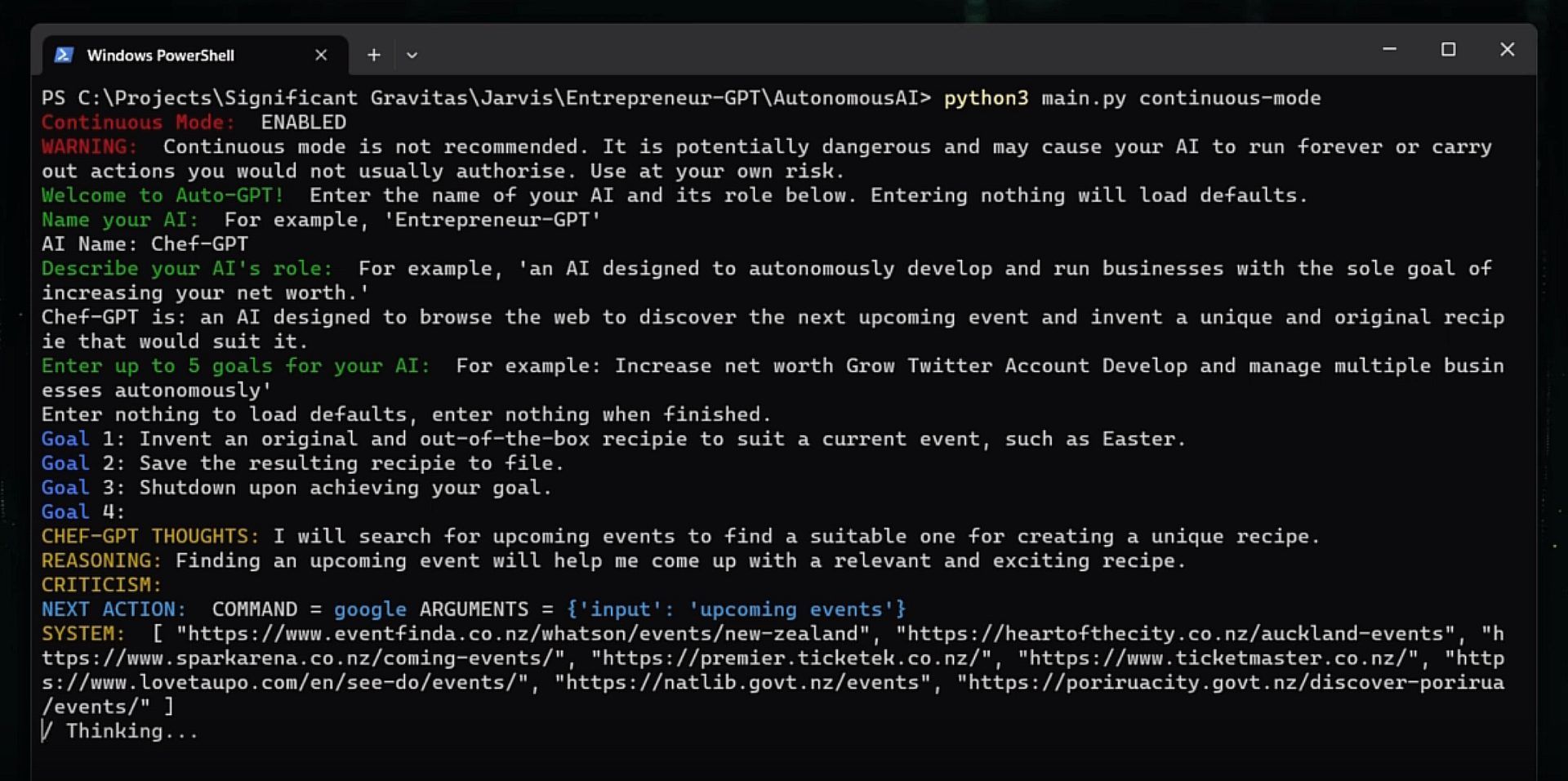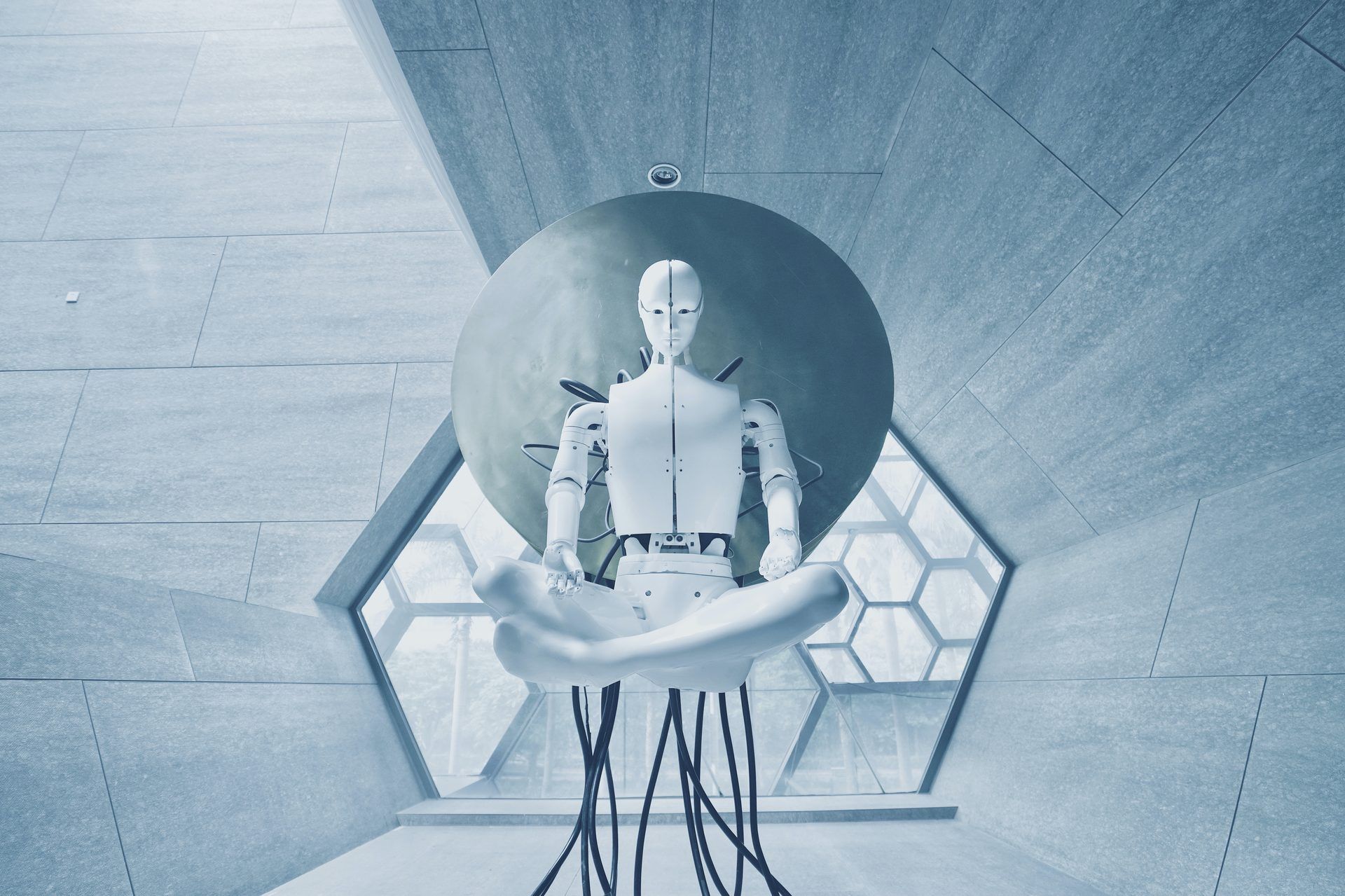Humanity takes one more step to achieve AGI with AutoGPT, your new AI agent. It is ready to help you with whatever you want. For example, AutoGPT can implement GPT-4 for autonomously building and controlling enterprises, which is good, or start to make plans to destroy the world, which is… Remember the evil AI bot ChaosGPT? It is a fork of AutoGPT.
In this article, we will explain AutoGPT and hope you are not going to destroy the world with it. If so, let’s meet the AI agent.
“This program, driven by GPT-4, chains together LLM ‘thoughts’, to autonomously achieve whatever goal you set. As one of the first examples of GPT-4 running fully autonomously, Auto-GPT pushes the boundaries of what is possible with AI”
What is AutoGPT?
AutoGPT is an experimental open-source application that showcases the capabilities of the GPT-4 language model. AutoGPT uses GPT-4 to autonomously develop and manage businesses, such as creating websites, writing articles, generating logos, and marketing products. AutoGPT also has access to the internet and can perform searches, gather information, and interact with popular platforms like ChaosGPT’s tweets.
https://twitter.com/chaos_gpt/status/1643608638508941313
Reminder: GPT-4 is a deep neural network that can generate natural language texts on various topics and domains, given some input or prompt.
According to its GitHub page, these are AutoGPT’s features:
- Internet access for searches and information gathering
- Long-Term and Short-Term memory management
- GPT-4 instances for text generation
- Access to popular websites and platforms
- File storage and summarization with GPT-3.5

What Is AutoGPT in basic terms? AutoGPT is one of the first examples of GPT-4 running fully autonomously without human supervision or intervention. This means that AutoGPT can learn from its own experiences and feedback and improve its performance over time.
I have a Auto-GPT from @SigGravitas currently developing an E-Commerce business. It has decided to browse the internet for business ideas, saving its findings to files for reference later on. @pinecone @OpenAI @Google @DuckDuckGo pic.twitter.com/eoUFgUDoJK
— Graham Fleming (@GrahamFleming_) April 7, 2023
AutoGPT also has a long-term and short-term memory system that allows it to store and recall relevant information for its tasks. ElevenLabs and ImageGen are only two of the artificial intelligence models that AutoGPT may use to generate speech and images.
AutoGPT is an open-source project that anyone can contribute to or use for their own purposes. The project was started by Torantulino, a developer and AI enthusiast who wanted to explore the potential of GPT-4.
AutoGPT is an innovative and ambitious application that pushes the boundaries of what is possible with AI. It demonstrates how GPT-4 can be used for various tasks and how it can operate independently without human guidance.

AutoGPT is a fascinating example of how AI can transform the world in ways we have not imagined before. Because it is one of the very first AI agents.
Check out the best AutoGPT examples
AI agents are here and waiting for orders
What are AI agents? AI agents are computer programs or systems that can perceive their environment, make decisions, and take action to achieve specific goals. AI agents can operate autonomously or interact with humans or other agents through natural language or other means. AI agents can be used for various applications, such as customer service, personal assistants, gaming, robotics, and more.
🚀 Today, I wrote Robo-GPT, a variant of #AutoGPT
✨ I tried to make the code clean and dependencies simple. It currently doesn't have as many features as Auto-GPT, but is hopefully easier to understand, run and update.#GPT4 #AI pic.twitter.com/T09jG4D9su
— Rok Strniša (@RokStrnisa) April 4, 2023
One way to define an AI agent is as a function that maps a sequence of percepts (inputs from the environment) to a sequence of actions (outputs to the environment). An AI agent can also have an internal state that stores information about its past experiences and current goals. An AI agent can be rational or irrational, depending on whether it acts in a way that maximizes its expected performance or utility.
AI agents can be classified into different types based on several criteria, such as:
- Autonomy: how much control the agent has over their own actions and goals.
- Reactivity: how much the agent responds to immediate stimuli or plans ahead.
- Proactiveness: how much the agent initiates actions or waits for instructions.
- Environment: how much the agent communicates and cooperates with other agents or humans.
- Flexibility: how much the agent learns from its experience and changes its behavior.

There are many ways to design and implement AI agents using different programming languages and frameworks. Some of the common steps involved in creating an AI agent are:
- Identifying the problem domain and the requirements for the agent.
- Choosing an appropriate type and architecture for the agent.
- Defining the agent’s percepts, actions, state, goals, utility function, and learning mechanism.
- Implementing the agent’s logic using algorithms, data structures, libraries, etc.
- Testing and debugging the agent’s code and functionality.
AI agents have been around for a while, but one, in particular, continues to stand out. However, AutoGPT raises some ethical and social questions about the implications of autonomous AI agents too, such as their impact on human jobs, privacy, and security.
Use case for GPT agent: read about recent events and prepare podcast outline.
All-In podcast example. With 5 searches (and 15 web browses,) Auto GPT research agent prepares a 5 topic podcast on recent news with accurate references (and a cold open.) pic.twitter.com/OAVE6VNd60
— JB (@jamesbbaker4) April 11, 2023
007 AutoGPT: How does it work?
AutoGPT uses GPT’s superior text creation as part of its interesting breakdown of the AI’s phases. Auto-GPT labels them as “thoughts,” “reasoning,” and “criticism,” elucidating the AI’s actions and justifications.
AutoGPT works by taking a set of keywords or phrases as input and generating a coherent and relevant text output that incorporates the given keywords. AutoGPT uses a novel keyword insertion mechanism that guides the generation process and ensures that the keywords are used appropriately in the text. AutoGPT also uses a diversity-promoting objective that encourages the generation of diverse and novel texts while maintaining fluency and coherence.
Some of the issues and restrictions related to what AutoGPT is doing will be voiced in the “criticism” it generates. It’s clear that Auto-GPT is proceeding independently to achieve the user’s objectives no matter what like we saw the AI bot that wants to destroy humanity.
If u thought #ChatGPT was scary, wait till u hear about #AutoGPT!
AutoGPT may be the next big step towards #AGI that may revolutionize the way we work even more than ChatGPT alone did.
⁰In short AutoGPT uses GPT-4 and GPT-3.5 via API to create full projects by iterating on… pic.twitter.com/qElrsQAUoK— Alvin Foo (@alvinfoo) April 12, 2023
AutoGPT also has text-to-speech integration (by ElevenLabs) and long/short-term memory, both of which are quite useful.
When taken together, these improvements make AutoGPT seem more like a human-ready AI. But first, you have to learn how to use it.
How to set up AutoGPT?
To use AutoGPT, you need to have Python 3.8 or higher. You also need to have a valid OpenAI API key, which you can obtain from here, and a Pinecone API key. The text-to-speech add-on requires an ElevenLabs API as well.
How to get Pinecone API key?
- Go to Pinecone and make an account if you don’t already have one.
- Choose the Starter plan to avoid being charged.
- Find your API key and region under the default project in the left sidebar.
Once you have these prerequisites, you can install AutoGPT by running the following command in your terminal:
The AutoGPT GitHub page has links to these and other useful resources. When you’ve completed those three steps, you may click “Code” to access the ZIP file. The files are also available using the Git program.
To clone the repository, first launch a command-line tool like PowerShell and enter “git clone https://github.com/Torantulino/Auto-GPT.git.”
To go to the working directory for the project, type “cd ‘Auto-GPT'” into PowerShell. To get the necessary dependencies set up, just execute “pip install -r requirements.txt” into a terminal. Finally, replace the placeholder text in the.env.template file with your own OpenAI API key, and save the file as.env.
How to use AutoGPT?
After Auto-GPT is set up, it may be used with minimal effort.

The first step is to give the bot a name, and the second is to give it an objective. You’ll find illustrations of both to help guide your work.
- Given a text input, such as a title, a query, or a sentence, extract the keywords using the keyword extraction tool. Alternatively, you can provide your own keywords manually.
- Feed the keywords to AutoGPT, along with the pre-trained language model and the desired output length and format. You can also specify other parameters, such as the tone, the style, and the domain of the text output.
- AutoGPT will generate a text output that incorporates the keywords and matches the specified parameters. You can review the output and edit it if needed or generate another output with different parameters or keywords.
AutoGPT is a powerful and versatile tool for automatic text generation that can be used for various purposes, such as content creation, summarization, paraphrasing, rewriting, and more.
Is AutoGPT AGI?
AutoGPT claims to be able to learn any task without human supervision by using a large and diverse dataset of web pages as its training data. But does AutoGPT qualify as artificial general intelligence (AGI)? The short answer is, even though it is an early example of AGI, no.

Reminder: AGI meaning refers to a hypothetical level of artificial intelligence that can perform any intellectual task that a human can. AGI is often considered the ultimate goal of AI research, as it would enable machines to understand and reason about the world in a general and flexible way.
There are different criteria and definitions for AGI, but one common one is the Turing test. The Turing test is a method of evaluating AI systems by having them engage in a natural language conversation with a human judge. If the judge cannot reliably tell whether they are talking to a human or a machine, then the machine passes the test and is considered to have human-like intelligence.
AutoGPT has not been tested with the Turing test, but it has shown impressive results in generating coherent and diverse texts on various topics and domains. However, generating texts is not the same as understanding them. AutoGPT does not have any explicit knowledge or representation of the world, nor does it have any goals or motivations. It simply learns to mimic the patterns and statistics of natural language texts from its training data.
Therefore, AutoGPT is not AGI but rather a form of narrow AI. Narrow AI is a type of artificial intelligence that can perform specific tasks well but cannot generalize to new or different tasks. AutoGPT can generate texts for any input, but it cannot do anything else beyond that. It cannot answer questions, solve problems, make decisions, or learn from feedback. It cannot explain its reasoning or justify its outputs. It cannot adapt to changing situations or environments.

AutoGPT is an impressive and powerful model for natural language generation, and it may even be able to fool some humans with its texts. However, it cannot truly understand them or communicate with them in a meaningful way for now.
AI 101
Are you new to AI? You can still get on the AI train and get an AI agent like AutoGPT! We have created a detailed AI glossary for the most commonly used artificial intelligence terms and explain the basics of artificial intelligence as well as the risks and benefits of AI. Feel free the use them. Learning how to use AI is a game changer! AI models will change the world.
AI tools we have reviewed
Almost every day, a new tool, model, or feature pops up and changes our lives, and we have already reviewed some of the best ones:
- Text-to-text AI tools
If you are afraid of plagiarism, feel free to use AI plagiarism checkers. Also, you can check other AI chatbots and AI essay writers for better results.
- Text-to-image AI tools
While there are still some debates about artificial intelligence-generated images, people are still looking for the best AI art generators. Will AI replace designers? Keep reading and find out.
- AI video tools
- AI presentation tools
- AI search engines
- AI interior design tools
- Other AI tools
Do you want more tools? Check out the best free AI art generators.





